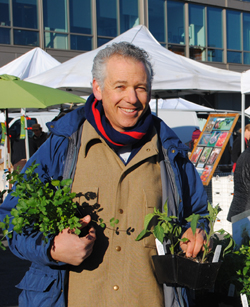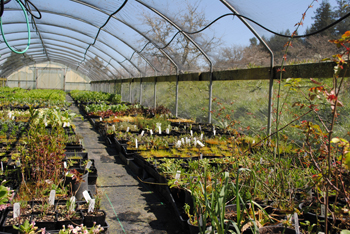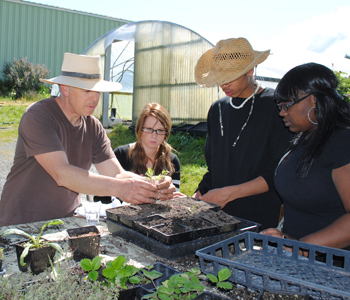Flatland Flower Farm Wants to Get You Growing
Brie Mazurek, CUESA Staff
March 2, 2012
 Spring rains have come and the days are getting longer, which means business is picking up for Dan Lehrer and Joanne Krueger of Flatland Flower Farm. The Sebastopol-based nursery has been providing plant starts to Bay Area gardeners at the Saturday Ferry Plaza Farmers Market since 1995. “We have customers who have been buying our starts for 17 years,” Lehrer says with pride. “People show us photographs and bring us tomatoes from plants they got from us. We get to share in people’s success.”
Spring rains have come and the days are getting longer, which means business is picking up for Dan Lehrer and Joanne Krueger of Flatland Flower Farm. The Sebastopol-based nursery has been providing plant starts to Bay Area gardeners at the Saturday Ferry Plaza Farmers Market since 1995. “We have customers who have been buying our starts for 17 years,” Lehrer says with pride. “People show us photographs and bring us tomatoes from plants they got from us. We get to share in people’s success.”
Flatland’s long history at the market belies its humble beginnings. In the 1990s, while Lehrer was completing a master’s in journalism at Berkeley and Krueger was working as a magazine editor, they moonlighted as helpers at the Berkeley Farmers Market. One cold February day, they decided to bring some bunches of cut sweet peas from their backyard garden to the market, and Flatland Flower Farm was born.
“The ‘farm’ part was kind of joke,” Lehrer laughs. “We’d have the organic inspector come and inspect our backyard. It was always funny.” They started selling their sweet peas and plant divisions regularly, and the business began to grow. While the two knew little about plant propagation, Krueger shadowed fellow marketeer Annabelle Lenderink of Star Route Farms to learn more about seeding.
In 1999, they decided to go full-time and purchased 22 acres in Sebastopol. “Originally, we were just growing plants between the trees in the apple orchard. We didn’t know deer would come and eat them,” said Lehrer. Their first growing season, they lost all of their starts to a late frost, because they hadn’t built any greenhouses yet. “I have to say, we’ve made every possible mistake you can make. It’s just been figuring it out as we go.”
Fresh Starts
 In 2008, after receiving a letter from one of their seed suppliers saying that vegetable seed sales were on the rise, Lehrer and Krueger decided to focus on edible plant starts, which now make up about 98 percent of their business. When the recession hit later that year, they were poised to meet the urban gardening boom. The nursery grows starts that will thrive in San Francisco’s cooler microclimates. “We’re not planning on Walnut Creek,” says Lehrer. “If you can grow it in the Sunset, you can grow it pretty much anywhere.”
In 2008, after receiving a letter from one of their seed suppliers saying that vegetable seed sales were on the rise, Lehrer and Krueger decided to focus on edible plant starts, which now make up about 98 percent of their business. When the recession hit later that year, they were poised to meet the urban gardening boom. The nursery grows starts that will thrive in San Francisco’s cooler microclimates. “We’re not planning on Walnut Creek,” says Lehrer. “If you can grow it in the Sunset, you can grow it pretty much anywhere.”
Though they’re no longer in the Berkeley flats and no longer a flower farm, the name has stuck, and Flatland now sells their starts to retail nurseries around the Bay Area. Remaining part of the farmers market community has been invaluable in helping Lehrer and Krueger find seed sources, stay on top of the popular vegetable varieties, and receive feedback on what works in what conditions. Being at the market every week also gives them the opportunity to educate and learn from their customers. “You can’t just say, ‘That’ll be $3.75’ and send people on their way, because many people don’t know how to grow stuff,” says Lehrer. The farm has also hosted school tours for CUESA’s Schoolyard to Market program, teaching San Francisco high school students about the basics of plant propagation.
For Lehrer and Krueger, growing a bit of your own food complements shopping at the farmer market as another basic way to connect with your local foodshed. “If you grow something yourself, it tastes that much better,” he says. “And there’s the aesthetic value, too. Even the lowly lettuces are beautiful. It’s nice to have this connection to your food and the natural world available at your doorstep.”
Ready, Set, Grow
Lehrer has talked to thousands of Bay Area gardeners over the years and offers a few tips to inspire and empower beginners.
 Don’t be shy. When buying plant starts, expect a conversation. “I always find out people’s back story when I’m talking to them because that’s crucial to giving them a successful growing experience,” says Lehrer. He asks a lot of questions (“Where do you live? What are the conditions like? What are growing now?”) and expects you to do the same.
Don’t be shy. When buying plant starts, expect a conversation. “I always find out people’s back story when I’m talking to them because that’s crucial to giving them a successful growing experience,” says Lehrer. He asks a lot of questions (“Where do you live? What are the conditions like? What are growing now?”) and expects you to do the same.
Start small. If you’re new to gardening, try growing low-maintenance and versatile herbs like thyme and rosemary, which are perfect for containers and are only harvested a bit at a time. All you need is a sunny windowsill. Arugula and lettuce are also ideal for newbies because they grow fast and are well suited to San Francisco’s varied microclimates.
Plant for success. Many beginning gardeners have their sights set on tomatoes, which, unfortunately, are not well adapted for San Francisco. Lehrer knows gardeners who have had success with certain tomato varieties, but if your plot is a container garden on a chilly, wind-swept balcony, you may be setting yourself up for disappointment. Instead, choose plants that are climate-appropriate. “The reality is, you can have great lettuce, great Swiss chard, and awesome kale,” he emphasizes, “but you have to be careful with tomatoes.”
Be water smart. Keep your plants hydrated and protect the soil by putting mulch, such as pebbles or bark, on top of your pots to slow down evaporation. Place saucers under your pots to catch water that can later be wicked back up by the plants. Lehrer recommends checking out The Urban Farmer Store for classes and supplies to make watering plants easier and more efficient.
Just do it. The best piece of advice Lehrer gives budding gardeners is to just do it: “The thing that prevents people from gardening is thinking they don’t know enough. The worst case scenario is that the plant doesn’t do well or you kill it. I can tell you that you are not a real gardener until you’ve killed some plants. But the more experience you get, the more you observe the way the plants grow and the more stuff starts to make sense.”
Get your plants starts from Flatland Flower Farm at the Saturday farmers market. For classes and other resources for urban gardeners, visit Garden for the Environment and The San Francisco Urban Agriculture Alliance.
Topics: Farmers, Urban farming
